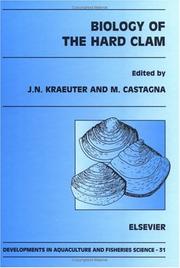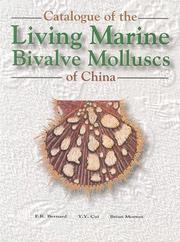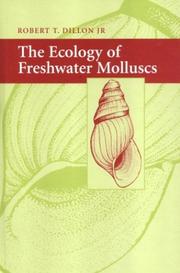| Listing 1 - 10 of 13 | << page >> |
Sort by
|

ISBN: 9780444819086 0444819088 9780080528014 0080528015 1281058149 9781281058140 9786611058142 6611058141 Year: 2001 Publisher: New York Elsevier
Abstract | Keywords | Export | Availability | Bookmark
 Loading...
Loading...Choose an application
- Reference Manager
- EndNote
- RefWorks (Direct export to RefWorks)
The hard clam, Mercenaria mercenaria, is an important commercial, recreational and ecological inhabitant of coastal bays along the east and gulf coasts of the United States. This title represents the first state of the art summary of existing knowledge of the hard clam by experts in various disciplines.Containing a compendium of literature on the hard clam, comprehensive chapters on various aspects of its biology as well as summaries of knowledge including the gray literature on this economically important species, this volume represents a comprehensive source of biological informatio
Northern quahog. --- Bivalves --- Physiology.

ISBN: 1282705601 9786612705601 9882200559 9789882200555 9622093248 9789622093249 Year: 1993 Publisher: Hong Kong Hong Kong University Press
Abstract | Keywords | Export | Availability | Bookmark
 Loading...
Loading...Choose an application
- Reference Manager
- EndNote
- RefWorks (Direct export to RefWorks)
This is a comprehensive catalogue of the living marine Bivalvia of China. Over 1,140 species are arranged in systematic order reflecting the phylogenetic relationships of the supraspecific taxa, together with almost 3,500 binomina which fall into synonymy. Bathymetric, substrate, and geographic distributional data are given.
Book
ISBN: 1282705474 9786612705472 9882200419 9789882200418 Year: 1990 Publisher: Hong Kong Hong Kong University Press
Abstract | Keywords | Export | Availability | Bookmark
 Loading...
Loading...Choose an application
- Reference Manager
- EndNote
- RefWorks (Direct export to RefWorks)
Bivalves --- Yonge, C. M. --- Mollusks
Book
ISBN: 1626180849 9781626180840 9781626180833 1626180830 Year: 2013 Publisher: Hauppauge, New York
Abstract | Keywords | Export | Availability | Bookmark
 Loading...
Loading...Choose an application
- Reference Manager
- EndNote
- RefWorks (Direct export to RefWorks)
Mussels --- Mytilidae. --- Marine mussels --- Sea mussels --- Mytiloida --- Bivalves --- Ecology. --- Life cycles. --- Control.
Book
ISBN: 1634851404 9781634851404 9781634851237 Year: 2016 Publisher: Hauppauge, New York
Abstract | Keywords | Export | Availability | Bookmark
 Loading...
Loading...Choose an application
- Reference Manager
- EndNote
- RefWorks (Direct export to RefWorks)
Fishery products --- Bivalves --- Acephala --- Aglossa --- Anodontoda --- Bivalvia --- Conchifera --- Conchophora --- Cormopoda --- Dithra --- Elatobranchiata --- Elatocephala --- Eulamellibranchia --- Lamellibranchia --- Lamellibranchiata --- Lipocephala --- Pelecypoda --- Teleodesmacea --- Tropipoda --- Mollusks --- Aquatic resources --- Inspection --- E-books

ISBN: 1107111501 0511052383 0511324987 0511173407 0511152450 0521359910 0511542003 9786610432059 1280432055 0511017286 9780511017285 0511037155 9780511037153 9780511152450 9780511052385 9780511173400 9780521352109 052135210X 9780511542008 9780521359917 Year: 2000 Publisher: Cambridge New York Cambridge University Press
Abstract | Keywords | Export | Availability | Bookmark
 Loading...
Loading...Choose an application
- Reference Manager
- EndNote
- RefWorks (Direct export to RefWorks)
This book provides a comprehensive review of the ecology of freshwater bivalves and gastropods worldwide. It deals with the ecology of these species in its broadest sense, including diet, habitat and reproductive biology, emphasising in particular the tremendous diversity of these freshwater invertebrates. Following on from these introductory themes, the author develops a life history model that unifies them, and serves as a basis for reviews of their population and community ecology, including treatments of competition, predation, parasitism and biogeography. Extensively referenced and providing a synthesis of work from the nineteenth century onwards, this book includes original analyses that seek to unify previous work into a coherent whole. It will appeal primarily to professional ecologists and evolutionary biologists, as well as to parasitologists.
Gastropoda --- Bivalves --- Freshwater invertebrates --- Aquatic invertebrates --- Freshwater animals --- Acephala --- Aglossa --- Anodontoda --- Bivalvia --- Conchifera --- Conchophora --- Cormopoda --- Dithra --- Elatobranchiata --- Elatocephala --- Eulamellibranchia --- Lamellibranchia --- Lamellibranchiata --- Lipocephala --- Pelecypoda --- Teleodesmacea --- Tropipoda --- Mollusks --- Gasteropoda --- Gastropods --- Ecology. --- Ecology
Book
ISBN: 3030662551 3030662543 Year: 2021 Publisher: Cham, Switzerland : Springer,
Abstract | Keywords | Export | Availability | Bookmark
 Loading...
Loading...Choose an application
- Reference Manager
- EndNote
- RefWorks (Direct export to RefWorks)
The monograph focuses on the European freshwater pearl mussel Margaritifera margaritifera, which is an endangered bivalve species. Most of its populations in the Russian section of the Baltic Sea basin had never been studied, although they were known in the past to the pearl fishers. “Rediscovery” included search for the previously unknown populations, revealing the facts of population extinctions, analysis of negative impacts, elaboration of conservation measures, and revealing of regularities in distribution. Patterns of land use and river management were analyzed. The procedure of “rediscovery” was applied for other animal species of Northwest Russia, which are threatened on a global scale – thick-shelled mussel, Unio crassus; curlew Numenius arquata; black-tailed godwit, Limosa limosa; Northern Lapwing, Vanellus vanellus; European mink, Mustela lutreola; pond bat, Myotis dasycneme; Atlantic sturgeon, Acipenser sturio; and broad-clawed crayfish, Astacus astacus. The methods and principles of conservation studies were discussed. The obtained data were analyzed with respect to current global change of biosphere. The book will appeal to specialists dealing with conservation studies and activities such as red lists, river protection, and conservation of endangered species. Moreover, a part of the book represents an interest for biogerontology as it presents discredit of the popular concept on “negligible senescence.” The data on distribution of some animals in Russia will be interesting in terms of zoology and biogeography, as they are not yet sufficiently represented in the international editions. The book can be used as supplemental reading for courses in biological invasions, ecology and conservation, and biodiversity. The work also contains chapters on global processes (deforestation, desertification, river degradation) and can therefore also be used for general courses in environmental sciences.
Aquatic ecology . --- Conservation biology. --- Ecology . --- Biodiversity. --- Animal ecology. --- Freshwater & Marine Ecology. --- Conservation Biology/Ecology. --- Animal Ecology. --- Animals --- Zoology --- Ecology --- Biological diversification --- Biological diversity --- Biotic diversity --- Diversification, Biological --- Diversity, Biological --- Biology --- Biocomplexity --- Ecological heterogeneity --- Numbers of species --- Balance of nature --- Bionomics --- Ecological processes --- Ecological science --- Ecological sciences --- Environment --- Environmental biology --- Oecology --- Environmental sciences --- Population biology --- Nature conservation --- Aquatic biology --- Margaritifera margaritifera. --- Margaritana margaritifera --- Margaritifera --- Bivalves --- Conservació de la diversitat biològica --- Bàltica (Mar) --- Rússia (Federació) --- Conservació de la biodiversitat --- Preservació de la biodiversitat --- Preservació de la diversitat biològica --- Conservació dels recursos naturals --- Gestió dels ecosistemes --- Acèfals --- Bivalvia --- Conquilles bivalves --- Lamel·libranquis --- Mol·luscs bivalves --- Pelecípodes --- Mol·luscs --- Cloïsses --- Musclos --- Ostres --- Federació Russa --- Rossiskaja Federacija --- Russian Federation --- Bàltic (Mar) --- Mar Bàltic --- Mar Bàltica
Book
ISBN: 1283350289 9781420049787 1439839123 1439839093 042910653X 9786613350282 9781439839096 1000218791 Year: 2012 Publisher: Boca Raton : Taylor & Francis,
Abstract | Keywords | Export | Availability | Bookmark
 Loading...
Loading...Choose an application
- Reference Manager
- EndNote
- RefWorks (Direct export to RefWorks)
Exploring the potential use of bivalves as indicators and monitors of ecosystem health, this book describes live and computer simulated experiments, mesocosm studies, and field manipulation experiments. This second edition discusses major new developments, including phase shifts in many coastal and estuarine ecosystems dominated by suspension-feeding bivalves, the invasion or introduction of alien bivalve species, the rapid growth of environmental restoration focused on bivalves, and the examination of geological history with regard to global climate change and its impact on bivalve-dominated systems.
Bivalves --- Marine invertebrates --- Biotic communities. --- Ecology. --- Biocenoses --- Biocoenoses --- Biogeoecology --- Biological communities --- Biomes --- Biotic community ecology --- Communities, Biotic --- Community ecology, Biotic --- Ecological communities --- Ecosystems --- Natural communities --- Ecology --- Population biology --- Aquatic invertebrates --- Marine animals --- Acephala --- Aglossa --- Anodontoda --- Bivalvia --- Conchifera --- Conchophora --- Cormopoda --- Dithra --- Elatobranchiata --- Elatocephala --- Eulamellibranchia --- Lamellibranchia --- Lamellibranchiata --- Lipocephala --- Pelecypoda --- Teleodesmacea --- Tropipoda --- Mollusks
Book
ISBN: 0520942523 9780520942523 9781435684799 1435684796 0520255267 9780520255265 9780520255265 052091614X 128175269X 9786611752699 6611752692 Year: 2008 Publisher: Berkeley University of California Press
Abstract | Keywords | Export | Availability | Bookmark
 Loading...
Loading...Choose an application
- Reference Manager
- EndNote
- RefWorks (Direct export to RefWorks)
Pearly mussels (Unionoidea) live in lakes, rivers, and streams around the world. These bivalves play important roles in freshwater ecosystems and were once both culturally and economically valuable as sources of food, pearls, and mother-of-pearl. Today, however, hundreds of species of these mussels are extinct or endangered. David L. Strayer provides a critical synthesis of the factors that control the distribution and abundance of pearly mussels. Using empirical analyses and models, he assesses the effects of dispersal, habitat quality, availability of fish hosts, adequate food, predators, and parasites. He also addresses conservation issues that apply to other inhabitants of fresh waters around the globe and other pressing issues in contemporary ecology.
Freshwater mussels --- Clams, Freshwater --- Fresh-water mussels --- Freshwater clams --- Mussels, Fresh-water --- Naiades (Mollusks) --- Naiads (Mollusks) --- Unionacea --- Freshwater invertebrates --- Mussels --- Unionoida --- Ecology. --- bivalves. --- conservation issues. --- contemporary ecology. --- critical approach. --- cultural value. --- economic value. --- endangered species. --- extinct mussels. --- food mussels. --- freshwater ecology. --- freshwater ecosystems. --- freshwater lakes. --- habitat quality. --- healthy ecosystems. --- mother of pearl. --- mussel abundance. --- mussel distribution. --- mussel ecology. --- mussel populations. --- mussel predators. --- mussels. --- parasites. --- pearls. --- pearly mussels. --- rivers and streams. --- scientists. --- textbook. --- zoology.
Book
ISBN: 3319060317 3319060309 Year: 2014 Publisher: Cham : Springer International Publishing : Imprint: Springer,
Abstract | Keywords | Export | Availability | Bookmark
 Loading...
Loading...Choose an application
- Reference Manager
- EndNote
- RefWorks (Direct export to RefWorks)
Water and moisture undermine strong adhesion to polar surfaces. Marine mussels, however, achieve durable underwater adhesion using a suite of proteins that are peculiar in having high levels of 3, 4-dihydroxyphenylalanine (Dopa). Mussel adhesion has inspired numerous studies on developing the next generation of wet adhesives. This thesis presents recent progress in understanding the basic surface and intermolecular interactions employed by mussels to achieve strong and durable wet adhesion. The surface forces apparatus (SFA) and various other techniques were applied to measure the interactions between mussel foot protein-3 fast (Mfp-3 fast) and the model substrate, mica, as well as the interactions between various mussel adhesive proteins. The results in this thesis show that Dopa plays an essential role in mussel adhesion, and that mussels delicately control the interfacial redox environment to achieve strong and durable Dopa mediated adhesion. The interplay between Dopa and hydrophobic interactions is also evident in mussel adhesion.
Mussels. --- Adhesives --- Curing. --- Agglutinants --- Bonding agents (Adhesives) --- Binders (Materials) --- Cement --- Cements, Adhesive --- Glue --- Mucilage --- Bivalves --- Biochemical engineering. --- Surfaces (Physics). --- Biomedical engineering. --- Biomaterials. --- Biochemical Engineering. --- Surfaces and Interfaces, Thin Films. --- Biomedical Engineering and Bioengineering. --- Biocompatible materials --- Biomaterials --- Medical materials --- Medicine --- Biomedical engineering --- Materials --- Biocompatibility --- Prosthesis --- Clinical engineering --- Medical engineering --- Bioengineering --- Biophysics --- Engineering --- Physics --- Surface chemistry --- Surfaces (Technology) --- Bio-process engineering --- Bioprocess engineering --- Biochemistry --- Biotechnology --- Chemical engineering --- Materials—Surfaces. --- Thin films. --- Bioartificial materials --- Hemocompatible materials --- Films, Thin --- Solid film --- Solid state electronics --- Solids --- Coatings --- Thick films --- Biomaterials (Biomedical materials)
| Listing 1 - 10 of 13 | << page >> |
Sort by
|

 Search
Search Feedback
Feedback About UniCat
About UniCat  Help
Help News
News